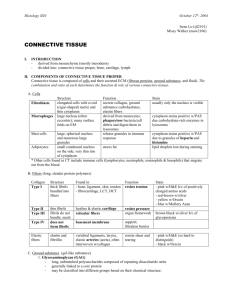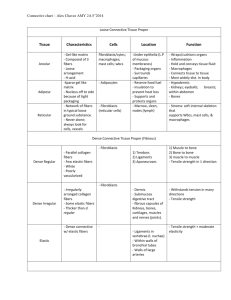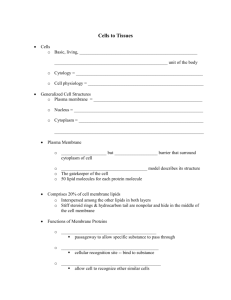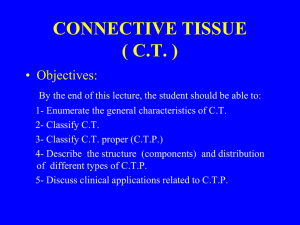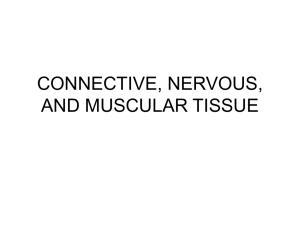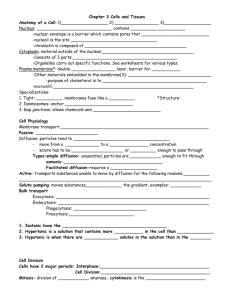Loose connective (areolar) tissue
advertisement
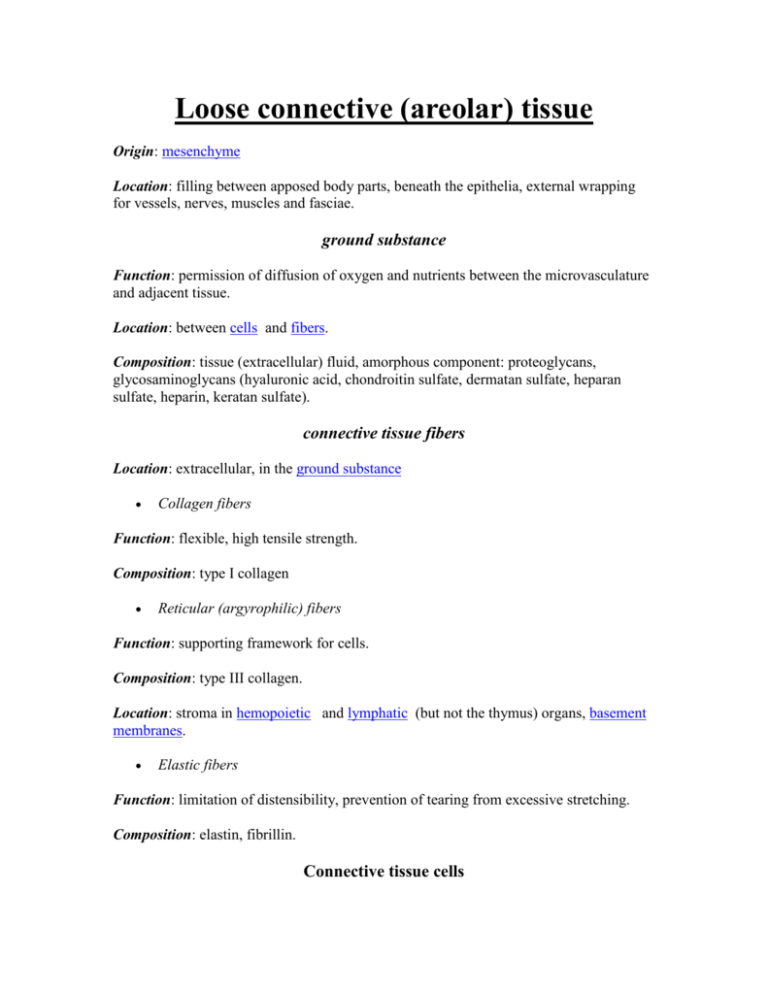
Loose connective (areolar) tissue Origin: mesenchyme Location: filling between apposed body parts, beneath the epithelia, external wrapping for vessels, nerves, muscles and fasciae. ground substance Function: permission of diffusion of oxygen and nutrients between the microvasculature and adjacent tissue. Location: between cells and fibers. Composition: tissue (extracellular) fluid, amorphous component: proteoglycans, glycosaminoglycans (hyaluronic acid, chondroitin sulfate, dermatan sulfate, heparan sulfate, heparin, keratan sulfate). connective tissue fibers Location: extracellular, in the ground substance Collagen fibers Function: flexible, high tensile strength. Composition: type I collagen Reticular (argyrophilic) fibers Function: supporting framework for cells. Composition: type III collagen. Location: stroma in hemopoietic and lymphatic (but not the thymus) organs, basement membranes. Elastic fibers Function: limitation of distensibility, prevention of tearing from excessive stretching. Composition: elastin, fibrillin. Connective tissue cells Fixed cell population Fibroblasts Function: synthesis of collagen, elastic and reticular fibers, and complex carbohydrates of the ground substance. Macrophages (histiocytes) Function: phagocytosis (defence activity and cleanup operation), immune reactions by presenting lymphocytes with antigens. Mast cells (tissue basophils, mastocytes) Function: synthesis and release of histamine, slow-reacting substance of anaphylaxis, eosinophil chemotactic factor of anaphylaxis, heparin, immune and inflammatory reactions. Adipose cells (adipocytes) Function: accumulation of neutral fat Adventitial cells (perivascular cells, pericytes) Function: undifferentiated cells, source of fibroblasts and blood vessels in repair (wounds healing). Location: around capillaries and venules. Plasma cells (plasmacytes) Function: antibody-producing cells derived from B lymphocytes Transient cell population Lymphocytes Neutrophils Eosinophils Basophils Monocytes Basement membrane (basal lamina) Function: structural attachment, filtration, compartmentalization (separation and isolation of the connective tissue from epithelia, nerve, muscle tissue), barrier. Composition: type IV collagen, proteoglycans, laminin, reticular fibers. Dense connective tissue Origin: mesenchyme Irrerular Location: dermis of skin. Origin: mesoderm: somites. Composition: relatively little ground substance, sparse cell population - fibroblasts, high proportion of collagenous fibers arranged in bundles oriented in various directions Regular Location: tendons, ligaments, aponeuroses. Composition: abundant fibers are arranged in a very orderly manner between which are rows of fibroblasts, sparse ground substance. Adipose tissue Origin: mesenhyme, adventitial cells Composition: ground substance, connective fibers, adipose cells. White (unilocular) adipose Location: hypodermis (panniculus adiposus under the skin), omentum, mesentery, retroperitoneal space, around the kidneys, breast. Function: energy and water storage, insulation, cushioning of vital organs. Brown (multilocular) adipose Location: hibernating animals, newborn humans. Function: source of heat and lipid, thermoregulation Bone Function: support, protection, storage site of calcium and phosphate. Origin: mesoderm: somites, mesenhyme. Mature: compact (dense) and spongy (cancellous) Location: skeletal system: long, short, flat and irregular bones. Ground substance Composition: proteoglicans, noncollagenous glycoproteins, hydroxyapatite crystals (calcium phosphate) Collagen fibers Location: parallel orientation in lamellar bone: osteons (Haversian system), interstitional lamellar, circumferential lamellar. Composition: mineralised. Cells Osteoprogenitor (periosteal, endosteal, bone-lining) cells Function: proliferation and differentiation into osteoblasts, nutritional support of the osteocytes, bone repair. Location: innermost layer of periosteum and endosteum in marrow cavities, osteonal (Haversian) canals and perforating (Volkmann's) canals Osteoblasts Function: secretion and mineralization of extracellular matrix: ground substance and collagen fibers, physiological and repair regeneration. Location: initial nonmineralized bone - osteoid, periosteum, endosteum. Osteocytes Function: mature bone cells, differentiated osteoblasts, maintenance of bone matrix by secretion and resorption. Location: lacunae in extracellular matrix. Osteoclasts Function: bone resorption, phagocytosis, bone remodelling. Location: bone surface. Origin: mesenhyme, bone marrow, blood monocytes, mononuclear phagocytic system. Immature (nonlamellar, bundle, woven) Function: support, protection, and storage site of calcium and phosphate. Location: skeleton of the developing fetus Composition: ground substance, thick collagen fibers in interlacing arrangement, randomly arranged abundant cells. Cartilage Function: support, protection, weight-bearing at points of movement. Origin: mesoderm: somites, mesenhyme. Hyaline cartilage Location: initial skeleton of the fetus, epiphyseal growth plate (epiphyseal discs) in bones, articular cartilages of joints, trachea, bronchi, larynx, nose, the ends of the ribs. Ground substance Composition: water, glycosaminoglycans: hyaluronic acid, chondroitin sulfate, keratan sulfate. Collagen fibers Composition: predominantly type II collagen Cells Prechondroblasts Function: proliferation and differentiation into chondroblasts. Location: inner cellular layer of perichondrium. Chondroblasts Function: secretion of extracellular matrix: ground substance and collagen fibers Chondrocytes Function: differentiated chondroblasts. Location: cell clasters (isogenous groups) of inner part of cartilage. Elastic cartilage Location: external ear, walls of the auditory (Eustachian) tube, epiglottis, and larynx. Composition: ground substance, elastic fibers and lamellae, cells. Fibrocartilage Location: intervertebral discs, symphysis pubis, articular discs of the sternoclavicular and temporomandibular joints, menisci of the knee joint. Composition: ground substance, collagen fibers as dense regular connective tissue , cells. Hemopoietic tissue Function: blood cell production. Location: bone marrow Reticular tissue Function: support for the developing blood cells, production of reticular fibers, secretion of several Colony-Stimulating Factors. Composition: ground substance, reticular fibers, reticular (adventitial) cells. Hemopoietic cells Hemocytoblast (Colony-Forming Unit) Function: pluripotential stem cell that give rise to all of the blood cell lines found in the bone marrow. ERYTHROPOIESIS Proerythroblast Basophilic erythroblast Polychromatophilic erythroblast Normoblast Polychromatohpilic erythrocyte Erythrocyte GRANULOPOIESIS Function: development of neutrophils, eosinophils, basophils. Myeloblast Promyelocyte Myelocyte o neutrophilic o eosinophilic o basophilic Metamyelocyte o neutrophilic o eosinophilic o basophilic Mature granulocytes o Band cell, Neutrophils o Eosinophils o Basophils Monocyte development Monoblast Promonocyte Monocyte Macrophage Megakaryocyte development Megakarioblast Promegakaryocyte Megakaryocyte Platelets LYMPHOPOIESIS Lymphopoietic stem cells Function: leave the marrow and travel to the thymus where they become T lymphocytes. Transitional cells Lymphocytes Lymphatic tissue Function: immune response. Location: thymus, spleen, lymph nodes, lymphatic nodules, and diffuse lymphatic tissue Supporting tissue Function: fine supporting meshwork for lymphocytes, macrophages, plasma cells; secretion of ground substance and fibers; phagocytosis Composition: ground substance, reticular fibers, reticular (adventitial) cells (except for the thymus), epithelioreticular cells (thymus). Cells Function: all stages of proliferation and differentiation of the immunocompetent cells. Lymphocytes o T lymphocytes Function: cell- mediated immunity o B lymphocytes Function: humoral immunity and production of antibodies plasma cells macrophages Embryonic connective tissue Mesenchyme Function: primitive connective tissue Composition: Ground substance Sparse collagen fibers, reticular fibers Mesenchyme cells Function: secretion of ground substance, fibers, proliferation and differentiation into different connective tissue cell types, smooth muscle cells, blood cells, et al. Mucous connective tissue Function: high turgor to resist compression. Location: umbilical cord Composition: Ground substance rich in hialuronic acid Collagen fibers Mucocytes (fibroblasts) Function: secretion of ground substance, fibers. Blood Function: convey nutrients, oxygen to cells, carrying wastes, carbon dioxide away from the cells, carrying hormones and other regulatory agents, homeostatic role based on its thermoregulatory and buffering capacity, protection from infections, foreign cells and proteins. Location: cardiovascular system. Origin: mesenhyme Plasma Function: convey nutrients, carrying wastes, carrying hormones and other regulatory agents, homeostatic role based on its thermoregulatory and buffering capacity, protection from infections, foreign cells and proteins. Location: cardiovascular system. Composition: water 91-92%, proteins (fibrinogens, globulins, albumin) 7-8%, other solutes 1-2%, electrolytes, nonprotein nitrogen substances (urea, uric acid, creatin...), nutrients (glucose, lipids, amino acids), blood gasses (oxygen, carbon dioxide, nitrogen), regulatory substances (hormones, enzymes) Formed elements (blood cells and cellular elements) Red blood cells (erythrocytes) Function: within the bloodstream, binding oxygen and, in exchange, binding carbon dioxide. Composition: hemoglobin: polypeptide chains with iron-containing heme group, degradation in spleen and liver. White blood cells (leukocytes) Function: transients within the blood, leave the blood through the walls of vessels to enter the specific sites of activity in the connective tissue Neutrophils (polimorphonuclear neutrophils) Function: phagocytosis of some bacteria, early phases of acute inflammation (pus). Composition: bacteriostatic and bacteriocidal agents (lysozyme), alkaline phosphatases in specific granules, peroxidase and lysosomal enzymes in azurophilic granules. Eosinophils Function: phagocytosis of antigen-antibody complexes, allergic reactions. Composition: major basic protein, arylsulfatase, histaminase, peroxidase and other hydrolytic enzymes in granules. Basophils Function: bind the antibody (IgE), release the vasoactive agents from the granules in association with hypersensitivity and anaphylaxis. Composition: hydrolytic enzymes, heparan sulfate, histamine and slow-reacting substance (SRS) of anaphylaxis in granules. Band (stab) cells Function: immature neutrophils Lymphocytes Function: recirculating immunocompitent cells; precursors of plasma cells, of cytotoxic T lymphocytes (killer, helper, supressor), of memory cells; hemopoietic stem cells (megakaryocyte); natural killer cells; immune reactions, late phases of acute inflammation, chronic inflammation. Monocytes Function: precursors of various phagocytes of the mononuclear phagocytic system: connective tissue macrophages, osteoclasts, alveolar macrophages, Kupffer cells in liver, macrophages of lymph nodes, spleen, bone marrow. Platelets Function: clot formation, retraction and, presumably, dissolution. Composition: serotonin and thromboplastin in very dense granules; lysosomal enzymes in lysosomal granules. Origin: bone marrow, megakaryocytes.


